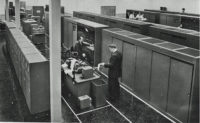
In 1956 I arrived at the office for my first day of work at the company then called Kreisler Borg in Westchester County, N.Y. The firm was one year old and had completed its first two jobs with a total contract value under $75,000. I was welcomed with jovial sentiments, then promptly presented with the plans and specifications for the next project to be bid.
I remember it well: the repairing of wooden fenders on the Cross Bay Parkway Viaduct in Queens. The work consisted of removing and replacing large creosote timbers along with some of the wooden piles to which they were attached. Below the waterline the connections consisted of metal brackets, and a considerable amount of underwater welding was required. This was not like anything I had seen before, but an estimate is an estimate—labor, materials and equipment—and the bid was due in about a week. I set to work. After a bit of quick research, I was able to speak somewhat knowingly on the telephone with owners of piledriving companies as well as with experts in marine carpentry, and most important, with a diver named Barney who specialized in underwater welding.
Barney came to our office, studied the plans carefully, assured me that he could handle the job with no difficulty and told me how much of his time to allow in our estimate for each connection—let us say it was one hour—totaling seven connections per working day. To be on the safe side, thought I, better make it six. Barney also quoted me his hourly rate, a staggeringly high amount; but after all, underwater welding is not your everyday construction activity.
I worked assiduously on the estimate and reviewed it carefully with my new employers. The cost, including a small contingency amount and a 15% mark-up, amounted to $105,000. Barney's work represented about $20,000 of the total.
To our surprise and delight, we were the low bidders. To our consternation we left a goodly sum "on the table," that is, the amount between our price and the second bidder. But, all in all, we started the job in great spirits.
That is until Barney called after visiting the site. "Damn," he said, "You didn't tell me about the tide." The tide? It seemed that the tide going in and out under the viaduct was so powerful that a diver could only work for about an hour, at high tide or low tide when the water was still. No six connections per day—only two. No $20,000 cost for the welding, but three times as much.
With a $40,000 overrun, our $15,000 profit would be replaced by a loss of $25,000. The tide! Who could have known? Well, we all should have known, including Barney, who felt "awful, just awful, guys!" but he hadn't given us a guaranteed price. It was an object lesson in the financial hazards of construction, and it threatened to be fatal.
But rather than default, we determined to plow ahead, trying desperately to find ways to maximize Barney's rate of production. Production wasn't helped when, on Oct. 8, 1956, word spread that Don Larsen of the Yankees was pitching a perfect game against the Dodgers in the World Series. Our superintendent, Bill Mullaly, announced that the job was going to shut down an hour early and all men would gather at a bar at Rockaway Beach to watch the final innings. Bill was buying the beer. Larsen's perfect game is history, and the crew enjoyed their beers. But that was the only pleasant episode to report. Despite our best efforts—and Barney's—a devastating loss seemed inevitable.
And then, on a miraculous day when the tide that threatened our ruin proved to be our salvation, we learned another object lesson in construction, and in life: It is possible to get lucky. A tugboat, misjudging the very tide that we had disregarded, was swept into our work area, smashing into the timbers, piles and welded braces. The work we had accomplished was substantially destroyed. But the company was saved. An insurance claim provided a happy ending to what could have been a tale of woe.
Samuel C. Florman's newest book, Good Guys, Wiseguys and Putting Up Buildings: A Life in Construction, went on sale March 13. This article is adapted from it.


Post a comment to this article
Report Abusive Comment